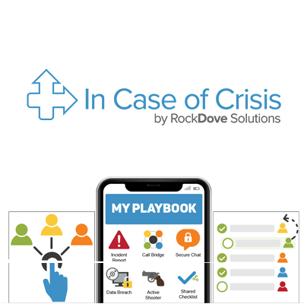Effective crisis communications with Christopher Britton | On Top of PR podcast
By On Top of PRJanuary 18, 2022

Christopher Britton and Jason Mudd discuss best practices for organizations to consider when preparing for inevitable crises. These involve leveraging technology, forming response plans, and practicing within your team.
If you’re enjoying the vodcast, would you please share it with others and leave us a review?
Guest:
Our episode guest is Christopher Britton, chief operating officer of RockDove solutions. He has decades of executive leadership experience and is known for creating and improving successful public and private companies, such as AT&T and Rosetta Stone.
Watch the episode here
Listen to the episode here
Important links:
- Special offer for On Top of PR fans: a three-month trial of In Case of Crisis with a $25 Amazon gift card
- The In Case of Crisis website
- Axia Public Relation’s CrisisPoint, crisis communication management packages
Guest’s contact info and resources:
Episode notes:
Hello, and welcome to On Top of PR, I'm your host, Jason Mudd with Axia Public Relations. And today, I'm joined by Christopher Britton. Christopher is the chief operating officer of RockDove Solutions. And Chris and I met for the first time in San Diego at the Public Relations Society of America conference, where his company was there demoing a software platform they developed called In Case of Crisis. Christopher Britton is a founding executive of RockDove Solutions, the developer of In Case of Crisis, an award-winning issues and crisis management platform serving hundreds of institutions globally. He has decades of executive leadership experience growing SaaS companies that are serving risk, crisis management, business continuity, public relations, and public affairs. So, without any further ado, Chris, welcome to the show.
Thank you, Jason. Thank you for having me.
Well, I'm glad to be here, and I'm glad you're with us as well. This is gonna be an interesting conversation 'cause I really like how niche your solution is and the service that you're providing to the profession. So, I'm gonna just kind of tee it up here and say, what you've developed is a platform that brands and companies can use in case of crisis, right? So a nice way to kind of get that crisis communications plan, not only in the cloud but also available on mobile devices and many other ways.
Chris, I won't pretend to know all the functions and capabilities of your product, but our goal here today is to not only get our audience a little bit more familiar with it but more importantly, inform and educate them on what they should be thinking about is the right way to proceed in case of crisis, whether maybe we're sharing some tips of how they might do some of this on their own and or some of the features and benefits of finding a solution like yours or something else that will help them kind of manage efficiently during a crisis 'cause we all know that when a crisis happens, it happens quick and there's not a lot of time to make a lot of decisions 'cause you have to make so many other decisions and be kind of on in so many different ways.
So one thing we've done at Axia, for example, is we've created a crisis package pricing on our website at axiapr.com/crisis, where we hope people will quickly see some of the options, there'll be an option there for them that they can point, click, engage us so that we can start moving very quickly 'cause there's often not time for anybody to prepare a proposal and a contract and negotiate and talk through expectations versus like, "Hey, we need a PR agency right now." And so I imagine very similarly, that's the challenge you're trying to solve for brands and corporations is they find themselves in the midst of a crisis, and hopefully, they did their due diligence. They've got a platform and a plan and a process to engage, and you've got a solution to kind of help them with that. Chris, fill in the blanks, where I have led our audiences astray.
No, Jason, you did a fabulous job of kind of teeing up some of the basics. I'll tell you what's happened, in kind of where we are plugging in now often is organizations are facing a broad set of threats and challenges. So in the days before, a crisis came along every so often and issues were able to be handled at a department level. No more. We now see organizations dealing with everything from cyber threats to a global pandemic to issues surrounding civil arrest and overall climate change events that are going on that are challenging our organizations in ways like never before.
Sure.
So where in the past organizations were looking at, how do I get really efficient and really quick at responding to that one big event that might happen? The new normal is organizations are actually juggling at any one point in time, many different issues and potential crises. And we see that over and over again in the clients that we work with and we're speaking to. So it means that we need to be really fast at responding. Also, communications professionals now need, you mentioned preparedness, we also need connectivity more so than ever before. Communications folks are dealing directly with the C-suite in a very interactive way 'cause a lot of these issues in crises are important and they need to be directly engaged closely with leadership in the organization as well they have the double challenge that employees more than ever need to be engaged in an efficient and effective way.

In Case of Crisis has tools that can be used as a guideline for companies on how to respond to a crisis.
Excellent. So, give me the backstory; your organization saw a need in the marketplace and decided to respond. And what was the gap, the solution, you were trying to fill?
Well, like everything, it started off simple. We had gone through a decade in the 2000s with one traumatic event after another with the shootings, the earthquake at the monument when the DC market, things like that, things like 9/11, Virginia Tech; we saw a gap where the plans and procedures that organizations were operating against for these types of events were not accessible to the everyday employee, let alone leadership. They were collecting dust and often sitting on a shelf somewhere. We had the advent of the mobile device, and we saw a great opportunity to provide that needed capability of access to actionable role-based information that individuals could have immediately at their fingertips in the form of a plan. So that began our journey, and we launched officially at the London Olympics in 2012, helping out the Olympic Village with 24-hour fitness and the athletes. And it was a great event. It got us an Olympic start, we always say. And from there, we really started to focus on the challenges associated with execution around response efforts.
Okay, awesome. So, at the end of the day, talk a little bit about what are some best practices that corporate communications and marketing professionals need to be thinking about when preparing their organization for a crisis.
Yeah, that's a great question. So first and foremost, organizations need to be putting together the obvious scenarios that they see out there that they think are relevant. Things that have to do with the topics we just spoke of earlier, like civil unrest and social media and this information and other challenges that organizations are running into have prepared statements in place that you can work from.
Secondly, you need to make sure that as an organization, you prepare the type of communication and information in an accessible format for your stakeholders, identify those stakeholders, identify those audiences, prepare your management team by having in place, good workflow, and good best practices on protocol response. So that everybody knows ahead of time some of the things we need to do from a muscle memory standpoint, create training and drilling opportunities. It's a great practice at least once a month to run some basic training and drills, twice a year to review those protocols and make sure they're up to date and they're accurate. Three, leverage technology. Technology is what is causing, in many cases, the acceleration of escalations around different events. So, in order to combat that you need technology to create an effective and efficient response.
Well, you're reminding me of how there used to be a time where we weren't hearing about crisis situations as often as you kind of indicated earlier. And one thing I used to do is bring a crisis that's headlining in the news and saying, "What if this happened to our organization, or what if this happened to you, client brand, how would you handle that? And is our crisis plan written to accommodate a potential crisis like this?" As you kind of mentioned too earlier, there's kind of the usual suspects, the things that could likely happen at your organization. And I said likely happened because there's the cliche of, it's not a matter of if but when you go through a crisis.
And we all know 40% of all companies never recover from a crisis. We also know that for every dollar spent proactively on crisis planning and management, you'll save apparently $7 according to research for when you're dealing with a real crisis. So, that's a pretty good ROI if we can get the premise across that every company is gonna deal with a crisis at some point. And one of my favorite examples is we worked with a billion-dollar global corporation for about a decade before they had any crisis at all that we were involved in.
And then just that particular calendar year, for whatever reason, they had a series of significant crises where we were earning all of our money and then some for that 10 years where they had no crisis to where suddenly they were having just a series of significant crises. And it was interesting because they originally hired us because of a crisis that occurred. And so they were like, "We need to be better equipped and have a PR agency in place." And then for 10 years, it was kind of like crickets from a crisis standpoint, but then when it rained, it just poured.
And so I think that's really important for people to really be kind of thinking about. But I love your advice, maybe once a month you pull a headline where a crisis is going on and maybe it's over lunch, maybe it's over drinks. Maybe it's just a meeting in the conference room where you just say, "Hey, if this crisis happened at this company, are we prepared for it? How would we respond? And does our communications plan address that. And if it doesn't, how do we modify the communications plan to work for that?"
Absolutely. And what's great is now that we have digital means to do these exercises, you can execute them without having to pull everybody into the room. They can be halfway around the world in different parts of the world, at home, at an office location, and execute those training exercises. So it's critical to build that muscle memory.
Well, walk us through that. So how does that work exactly?

Crises are inevitable- it’s important to have plans in place for when one happens.
Yeah, so very simple. In our world with our platform, organizations are able to essentially create playbooks for all of their vested stakeholders. They're able to set up issues in the command center and they actually can walk through everything from a basic storyboard like, "Hey, call came in, who records it? How does it work its way into the organization as an incident?" One of the biggest challenges we often see is knowing what you need to know when you need to know it. And that often is the optics and the ability to see what's going on is the first challenge. So we try to work through that in the training exercise, as well as in the technology of making sure people have instant access to the information you need to see when something is happening. The second is having clear guidance on what steps we need to take and what team members need to be a part of it. Do we need general counsel? Do we need certain stakeholders to be there? And how do we bring them together?
So we wanna make sure those things are defined and that we have technology in place to make that an easy process to not only bring them together but having placed the clearer defined steps that they need to follow. And then, of course, we wanna make sure we can document the timing and the various interplay with communication out to the influencers and the stakeholders could be supply chain, it could be employees, make sure we actually go through those exercises and demonstrate that and then pull that together, showing our ability to mark the severity levels and then ultimately capture this information into after-action reporting. In our tool, it's an automated process, but it is an essential part of it. And then turning that into a knowledge base so the organization can take these training exercises along with live fire and be in a position to effectively learn, grow, and evolve as a response effort.
Interesting. Yeah, I'm looking forward to getting more into that, Chris, right now, we need to take our halftime break here, and we'll come back on the other side with Chris Britton and RockDove Solutions’ product called In Case of Crisis. You've been listening and watching On Top of PR, we'll be right back with you.
Welcome back to On Top of PR. I'm your host, Jason Mudd, and we're talking about crisis communications and how you can best prepare and manage crises. Welcome back to the show here. We're glad to have you back. And I'm really excited to talk to Chris more about their solution, In Case of Crisis. So Chris, we were kind of talking during the break for a minute about how there's kind of two challenges in crisis communications. I was thinking about silence where people don't talk and they just kind of, there's an old cliche, you stick your head in the sand and you show your rear, right? And you don't wanna do that. And then you also mentioned silos and how organizations have these silos and they need an ability to be brought together. So Chris, why don't you talk about that for a little bit for our audience.
Yeah, you bet. So, when we look at some of the biggest challenges in organizations and their speed of response and their effectiveness of response, it often centers around the fact that you have operational processes in place for the operations IT, HR and marketing and communications. And unfortunately, a lot of these systems aren't necessarily cohesive when it comes to responding to a crisis. Oftentimes, they represent individual workflows and processes, and it's very difficult for organizations to quickly come together with the full picture of what's going on, but also then the ability to communicate and respond as one organization. And that is critical. And communications plays a very important role in being able to enable that single message point and being able to glue together, and great tech will do this, helping communications and the other key areas of the business break down the silos from a communication standpoint. Not only that but getting information up and down the organization as well as through silos.
So Chris, when a company comes to you and they wanna engage In Case of Crisis, where do you see the typical buyer is or maybe even the ideal buyer? Where are they in their progress and their process of being crisis ready? Have they built some internal tools or spreadsheets? What does their situation appraisal look like when they first approach your organization? Or are most people on a platform already?
Well, I mean, there's typical, and then there's the reality that they come in all situations. When we work with organizations, often they either internally or through an advisor have built some basic protocols and plans that they would like to implement. And then we come along and help them turn it into a management system, a way to make it repeatable, efficient, and scalable, but it starts with them having some idea about plans and procedures, working with organizations like yours to help them identify and organize what some of their priorities are.
Well, I'm thinking of my teenage children; they work at a large supermarket chain, right? And so I can't imagine that the supermarket chain would have them on the In Case of Crisis app on their phone, for example. So who's the typical user of the platform or who's installing the app 'cause you do have it available as an app, correct?
Yeah, we do. So, clearly, there's a variety of users that organizations will bring into our platform. They can range from the management teams, communications, risk, business continuity, security, all the way down to store managers in the case of the example you brought up, they'll bring in store managers and key personnel out in the field, it can even go to the line employee depending on the types of situations, if they wanna do emergency disaster recovery type communication, we have a very effective way of handling all of these different scenarios and ways to implement the technology.
Okay. Gotcha. And I'm also thinking, just curious, is there a way where your app can bolt on to an employee app that they may have created for the organization?
Yeah, and actually thank you for bringing that up. One of the areas that we felt a lot of work is in fully integrating our solution to the Microsoft Teams world. Now, organizations can instantly create the adoption traction and set up of our technology platform right inside of Microsoft Teams. And so that's the most common way we're working with very large organizations.

Staying up to date with new technologies will provide new outlets to handle crises.
I was doing a little reading earlier this week about there seems to be a rise of whistleblower platforms that enable and encourage employees to kind of speak up when they're seeing something that's not being done right or well, or in compliance or other issues going on in the organization. So there's a framework or a path or a funnel where those submissions get reviewed and escalated and assigned to the right department or whatever it might be. Is that something that you guys are looking at also, would that be a scenario where your app could become available to every employee in the organization?
So we absolutely have organizations using us where they have the app in the hands of all their employees tens of thousands. In terms of the specific use case of the whistleblower, we started doing that type of thing in the schools with bullying and being able to create reporting that was anonymous for folks that wanted to have an anonymous reporting model. The other thing we do is we have the ability to direct all that into an Incident Command Center within our tool so that it could reach the right eyes, only the right eyes. And it's all encrypted; it's all safe in privacy and all that.
Very nice. Okay. Wow. Yeah, that sounds very impressive. Well, very good. So I'm just gonna ask 'cause I know we're gonna talk about this later, but if somebody is watching or listening in and they think this sounds very interesting, you have an opportunity for them to do a product demo, right?
Absolutely. So we're gonna provide a link here at the broadcast and if somebody comes to our link and request a demo, happy to give a complimentary tour of what we do, talk a little bit about what you're looking for, what your needs are, and if there's a fit we will offer as an incentive for your listeners a three-month bonus on top of the normal subscription term as an added bonus and a $25 Amazon gift card just for doing the demo.
Okay. Well, very cool. We'll be sure to put a link to that in the show notes, so they can go to the exact website address to sign up for that special offer. And thank you for extending that special offer to our audience for sure. I think that will be very, very helpful and interesting for them. I love that you're providing a platform where they can use some advice and counsel based on experience to make sure they get the best use out of the application. So in some ways, in my mind, it's kind of like a one-two punch. Not only do we have, I'll call it a virtual command center or virtual crisis center, where we can keep our processes and our documentation and all that in one place, but then they've also got the experience, Chris, of as you've said deploying this solution to did we say thousands of organizations, right? So from that experience and learned knowledge you're gonna bring a lot of value I would imagine to the people who explore this with you and have that conversation with you.
We have some really good best practice experiences. We've been through a number of issues and what organizations are facing now with this kind of concurrent model of issue management and being able to support a very diverse audience. So we have clients that have our services in use by truck drivers, retail employees, people working from home, a variety of situations and being able to connect them all and go beyond a simple alert communication which we do as part of the communication but giving stakeholders a really rich and usable toolkit, we call it a playbook that brings together advisory information, best steps, how to reach people, how to report and just all the things they need, and it can be customized branded to that organization. So they can really accomplish their mission from an overall communication perspective.
I meant to ask you this earlier, do you enable them to be able to kind of white label or private label the solution so it has their brand name on it?
Yes. So we do provide a branding capability within all the content they're building. So the app itself, the In Case of Crisis app, but all of the plans and protocols and things that they're doing can be completely branded in their own formatting workflow. One of the big things we do is we enable workflow, which is huge because you can imagine an organization that has a lot of people that are trying to communicate, with one of the biggest challenges being getting everybody on the same page and following a standard approach.
Yeah, for sure. I've been there personally trying to help clients do exactly that so I completely understand. Let's say, somebody says, "Wow, this is great. I can't do it right now because our budgets are frozen until next fiscal year or whatever it might be." Chris, what are some takeaways or value adds you could share with our audience so they can at least try to do some best practices on their own as they're DIYing something today? And it would also kind of, I guess, move them closer to being able to align with your solution in the future.

Assembling a response team, assigning responsibilities, and practicing protocols is key for effective crisis communications.
Yeah. So obviously the first thing we've talked about is building some basic protocols around the who, what, where, and in terms of a response to some of the scenarios that are likely to occur like cyberattacks, natural disasters, dealing with potentially social unrest or civil unrest. Some of those scenarios that based on your business, your suppliers, you put some basic thought into protocols working internally resource-wise or working with your advisor agency partner.
The second thing is to start assembling and practicing and getting people used to, "Hey, who's gonna do this, and who's going to do that?" And really getting them used to their role in the process. So identifying your teams and your people that need to be involved and then start using some of the basic corporate collaboration tools, teams, is a good example. I mean, at a very minimal level, you can at least communicate, at least have information that you're making available. Obviously, we have a much more robust approach given all that's going on, but as a starting point to your question, absolutely start with some of the basic tools and some of the basic muscle memory activities.
Okay, excellent. Chris, it's been a pleasure having you on the episode today. Thank you for making that special offer to our audience. We definitely wanna reward our loyal fans and audience and followers, and this is a great way for them to have yet another perk of staying On Top of PR. We're gonna be sure to put a link to this in the show notes, our episode notes, so that people can easily find them wherever they might consume this episode. I wanna thank you for coming on and sharing some of your responses and experience and developing the solution to advance the profession. And Chris, if there's anything I can do for you, please don't hesitate to let me know.
Jason, thank you very much for having me on, and to your audience, thank you for listening. Take care.
One more thing, Chris, if somebody wants to get ahold of you besides that, well, I guess that landing page is probably the best way to reach out to you guys, but I assume you're on LinkedIn as well.
We are on LinkedIn and of course, my direct email, if somebody would like to reach out to me directly is Britton, B-R-I-T-T-O-N@rockdovesolutions.com.
And then we're gonna put this in the episode notes, but if you wanna take advantage of Chris's offer for an Amazon gift card to do a demo of their solution, you can go to https://www.rockdovesolutions.com/contact-us-0. Please let me know how you liked it and what you thought about it as you tried it out 'cause I think it's really cool that Chris has carved out this niche space and offered something to help out fellow corporate communications and public relations professionals.
And with that, that's another episode of On Top of PR. We wanna thank you for tuning in. I want to thank our sponsor, ReviewMaxer, and Axia Public Relations for making this episode possible. If you enjoyed this episode, would you please take a moment and share it with a friend or colleague who you think would benefit from learning more about crisis communications, and perhaps consider using a platform like In Case of Crisis, so that they might have more success and more collaboration and more remote and disaster recovery capabilities using a smart tool like this? So, I've enjoyed this episode, I hope you did too. Thank you for tuning in.
Sponsored by:
- On Top of PR is produced by Axia Public Relations, named by Forbes as one of America’s Best PR Agencies. Axia is an expert PR firm for national brands.
- On Top of PR is sponsored by ReviewMaxer, the platform for monitoring, improving, and promoting online customer reviews.
- Burrelles has a special offer for On Top of PR fans. Check it out at burrelles.com/ontopofpr.

About your host Jason Mudd
On Top of PR host, Jason Mudd, is a trusted adviser and dynamic strategist for some of America’s most admired brands and fastest-growing companies. Since 1994, he’s worked with American Airlines, Budweiser, Dave & Buster’s, H&R Block, Hilton, HP, Miller Lite, New York Life, Pizza Hut, Southern Comfort, and Verizon. He founded Axia Public Relations in July 2002. Forbes named Axia as one of America’s Best PR Agencies.
Find more On Top of PR episodes on:
Topics: crisis communications, internal communications, On Top of PR




Comment on This Article